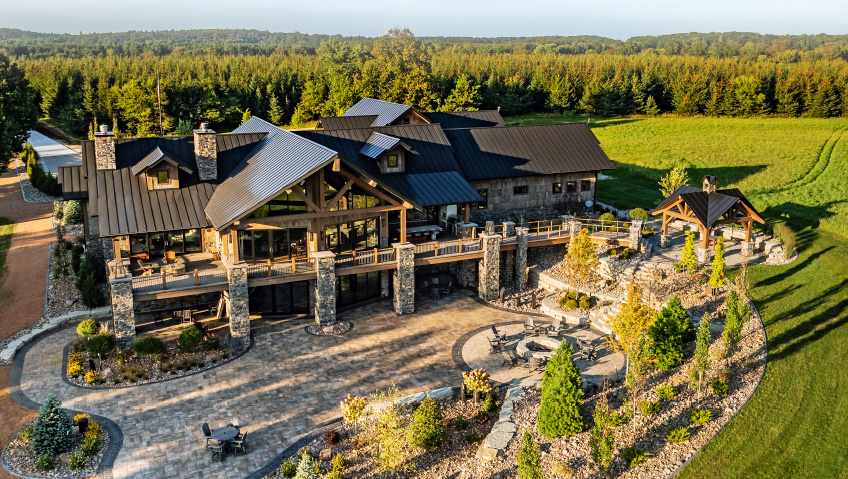In the heart of Central Wisconsin, Adams County is redefining what it means to be a rural community. Known for its scenic beauty and close-knit towns, the county is experiencing a revitalization driven by outdoor recreation, economic innovation, and a deep investment in its people.
At the helm of this transformation is Daric Smith, Executive Director of Adams County Economic Development (ACED), whose pragmatic, community-first approach is turning challenges into opportunities and laying the foundation for long-term prosperity.
Adams County’s most immediate and visible driver of growth is tourism, particularly outdoor recreation. The county’s abundant natural resources, including lakes, forests, and rolling terrain, provide the perfect backdrop for a wide range of year-round activities that are increasingly drawing visitors from across the Midwest and beyond.
“You’d be hard-pressed to find better golf in Wisconsin than all of the courses right here in Adams County,” says Smith, referencing renowned destinations such as Sand Valley Golf Resort, Northern Bay, and Lake Arrowhead. These golf courses have become economic anchors, not only attracting tourism dollars but also generating demand for lodging, restaurants, and second homes. “The ripple effect is massive. When people come for the golf, they spend at our gas stations, our restaurants, and our local shops. It builds out the whole economy.”
And the county isn’t putting all its eggs in the golf basket. ATV and UTV recreation are seeing rapid growth, with more roads opened to off-road vehicles and more visitors arriving specifically to explore the area’s trail networks. “With snowmobiles being down due to lighter winters, this has become one of our biggest recreational spikes,” says Smith. These visitors support small businesses in often-overlooked parts of the county, from convenience stores and mechanics to diners and campgrounds.
Festivals and public events organized by Visit Adams County, the local tourism bureau, have also become essential to building the county’s identity. Events like the Duck Derby and seasonal festivals not only attract tourism but also inspire pride and unity among residents. “We’re creating experiences that people will travel for, but more importantly, we’re giving locals something to celebrate,” Smith says.
While tourism has brought fresh energy, he emphasizes that true revitalization comes from within, and that means supporting entrepreneurs, small businesses, and local workers. ACED has implemented several grant programs designed specifically to help people turn business dreams into reality. One of the most impactful is the Business Plan Grant, which provides up to $2,500 for new and expanding businesses. This funding can be used for business registration, website development, inventory purchases, or marketing materials. “We’re lowering the barrier to entry,” says Smith. “Sometimes $2,500 is the difference between starting a business and giving up on the idea altogether.”
This grant has already helped launch a wave of women-led startups such as Wildflower Yoga and Bloom Fusion, along with high-growth businesses like Up North Brewing, which has quickly become a regional attraction. “They got the grant and within months were growing fast,” Smith shares. “That’s the kind of acceleration we’re aiming for—quick wins that lead to lasting success.”
Another innovative initiative is the Homestead Credit, designed to attract and retain workers by helping with the costs associated with purchasing or building homes located in Adams County. Available to existing employees and remote workers relocating to Adams County, this grant offers up to $2500 to incentivize Adams County workers to create their permanent residence within the county.
These programs reflect a deeper understanding of the real barriers rural residents face. Whether it’s housing affordability, access to capital, or simply a lack of confidence, Smith and his team are designing solutions grounded in lived experience, not theory. He believes that long-term success in Adams County depends not only on today’s entrepreneurs but on tomorrow’s workforce, and that’s why ACED has partnered closely with the Adams-Friendship Area School District to prepare students for real-world success through hands-on career development.
Programs like Reality Day, where students go through simulations of budgeting, housing, and real-life financial decisions, and Workforce Professionalism Day, which introduces students to job expectations, attire, and etiquette, are helping bridge the gap between school and the workforce. “We’re seeing kids have lightbulb moments. They’re realizing that work requires showing up, being respectful, and having basic financial literacy. These are lessons that can change their entire path.”
Local employers have also taken a proactive role, participating in career fairs, mock interviews, and work-based learning experiences. For students, these programs provide both motivation and clarity; for employers, they help build a reliable pipeline of local talent ready to enter the workforce. “We’re giving students exposure to jobs and businesses they didn’t even know existed in their hometown. And that plants the seed that they can have a future here.”
In 2023, Adams County was selected to participate in the USDA’s Rural Partners Network (RPN), a significant milestone that has brought structure, visibility, and funding potential to local efforts. The program connects rural communities with federal agencies and technical assistance, allowing them to access funding and support that would otherwise be out of reach.
“Being part of RPN means we’re not going it alone anymore,” Smith says. “We have partners at the federal level who understand rural needs and are helping us bring projects to life.”
The RPN structure helped us create working groups focused on priority areas such as housing, childcare, broadband, and downtown revitalization. These groups gather stakeholders from across the community from nonprofits to business owners, educators, and government leaders to plan and implement strategic initiatives. One early success has been a comprehensive housing study, which will guide decisions around zoning, development incentives, and infrastructure. “We can’t fix what we don’t understand,” Smith tells us. “This study gives us the data to attract developers and build the kinds of housing our residents actually need.”
Other initiatives include exploring rural transit models to support aging residents, coordinating regional childcare solutions to enable more parents to enter the workforce, and working to improve broadband connectivity, which is a critical factor for education, healthcare access, and remote work.
“These issues are all connected; you can’t attract a workforce if there’s no childcare, and people can’t work from home if they don’t have internet. RPN allows us to look at the whole picture.”
Perhaps the most inspiring part of Adams County’s story is its emphasis on building community and not just commerce. Revitalization efforts include beautifying downtown areas, supporting the arts, and enhancing civic spaces. “We’re not just trying to bring in money; we’re trying to make this a place people are proud to call home,” says Smith.
In tandem with ACED’s economic efforts, these community investments are helping to change the narrative around rural life. “People are realizing they can build something here, raise a family here, and be part of something meaningful.”
Adams County still faces challenges common to rural areas—like declining school enrollment, aging infrastructure, and a limited tax base—but the progress made in recent years offers a clear blueprint for what’s possible when a community comes together with a shared vision. “We’re not pretending everything is perfect,” says Smith. “But we’re not waiting for someone else to fix things either. We’re doing the work.”
That work, which is driven by partnerships, strategic planning, and a relentless belief in local potential, is paying off. The county is retaining talent, attracting visitors, supporting entrepreneurs, and building a stronger, more inclusive economy. “We’re showing that rural doesn’t mean stuck; it means adaptable. It means connected. It means full of potential.”
As Adams County continues to invest in its people, places, and partnerships, it stands as a powerful example of rural resilience, and a reminder that big things can happen in small communities.






